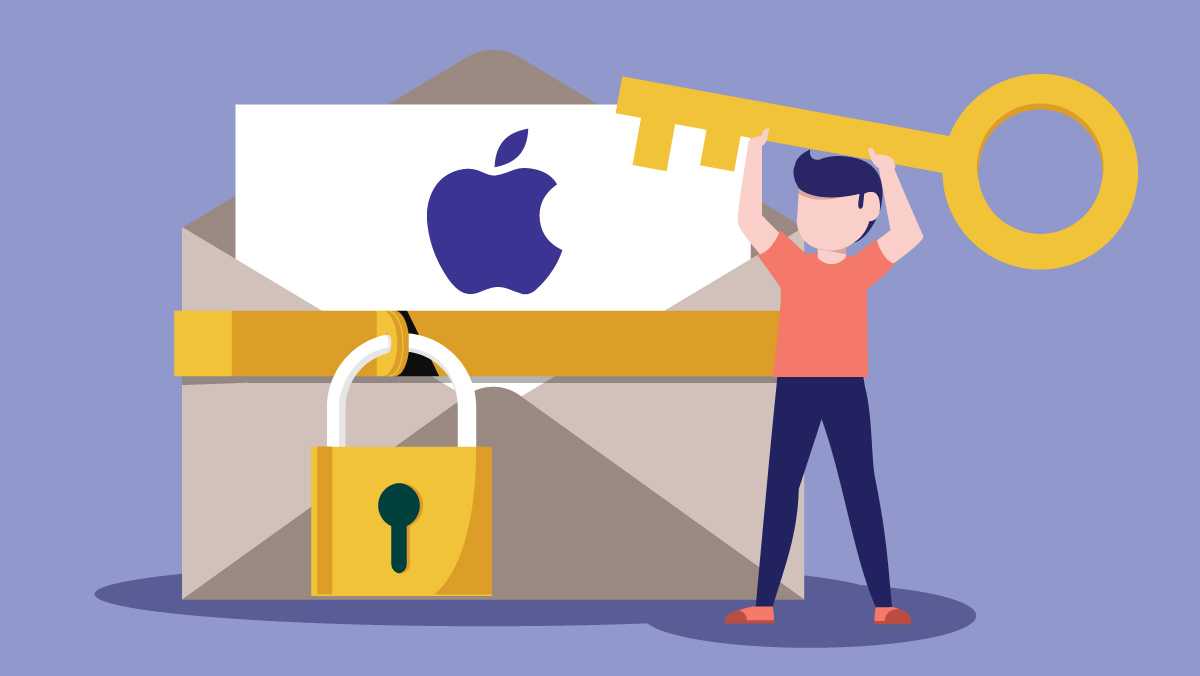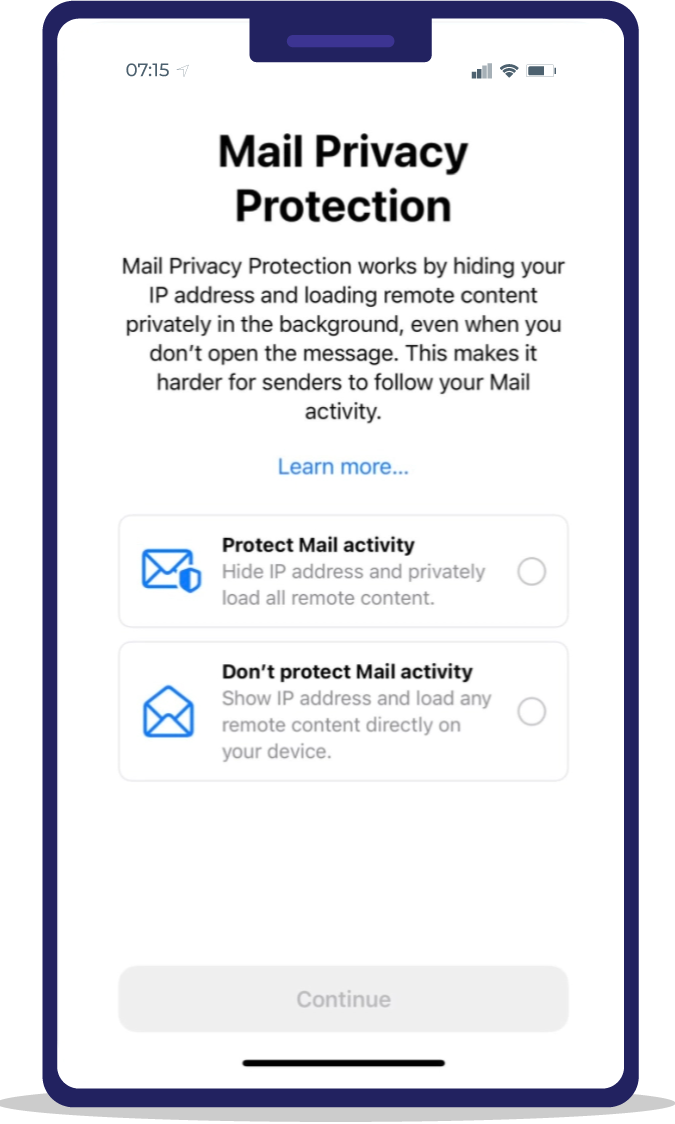At its Worldwide Developers Conference in June, Apple introduced its long-awaited iOS 15, an operating system that can have a major impact on your email campaigns. Why? In three words: Mail Privacy Protection.
Apple’s iOS15 will be rolled out at some time between September and November. Most new iOS15 features concern privacy, data tracking, and security. These features are relevant to you:- Mail Privacy Protection (free of charge): Apple Mail users will be asked whether they want to activate the new mail privacy feature. This feature masks IP addresses and makes tracking where and when a user opens an email impossible.
- iCloud+ (paid subscription): new privacy features you can take with an iCloud subscription, including a VPN-like Private Relay feature. It makes it impossible for websites to track Safari users.
- Hide My Email (within iCloud+): Apple also offers an email address cloaking feature, which enables users to submit a newly generated email address. Emails sent to this address will still be forwarded to the mailbox owner. As a company, however, you cannot retrieve the real email address. Additionally, users gain more ownership of who they want to relay their details to.
Mail Privacy Protection
Apple is rather vague about the details. So far, Apple has provided the following information:'In the Mail app, Mail Privacy Protection stops senders who want to use invisible pixels to collect information about users. The new feature helps users prevent senders from knowing when they open an email and masks their IP address, so that it cannot be linked to other online activities or cannot be used to identify their location.'
Apple has not explicitly indicated yet whether this is an option or an automatic feature. Meanwhile, Litmus and several other iOS testers have shared screenshots of the Mail app in which they are asked if they want to activate Mail Privacy Protection when the app is opened:
Mail Privacy Protection of iOS 15 and its impact on your email marketing (and open rate)
This is how it works
When the Apple Mail app is opened the first time after an update, the screen above is displayed, so Mail Privacy Protection is not activated by default.Apple users will recognise these kinds of options from the iOS 14.5 update, where they could indicate whether an app was allowed to trace their use. Only 4% indicated they allowed this type of tracking. If you look at the language used in the above screen, the response of most users will therefore not come as a surprise. After all, would anyone say: ‘Do not protect me’?!
So when you activate Mail Protection, the following will happen:
Apple will first route emails through a proxy server. The email content, including the tracking pixels, is loaded into this proxy server in advance. Next, the email will be shown to the reader. At that moment, an ‘open’ will be registered, even if the recipient will never really open the email.
Do you want to know more about the technical details? Then here is the juicy stuff. If you are not interested, just skip the section below and move on to the specific tips.
- When your recipient opens the Apple Mail app, the email will be downloaded from the web host or email service provider (ESP, i.e. Flexmail) to the recipient’s device.
- At that moment, mostly before the email is read, Apple caches all images in the email, saving a copy of the image to a new location. This is done in the Apple Privacy Cache, with an IP address that matches the general location of the recipient instead of the recipient’s specific geolocation. Litmus has tested this, and apparently recipients need to be connected to a wireless network while the Apple Mail app is running in the background.
- For this caching process Apple has to retrieve the images – as well as the tracking pixel – from your ESP’s server. It will register that the email was ‘opened’, so to speak.
- When the receiver actually opens the email, the images will be downloaded and displayed. Whereas they normally come from the web host or the sender’s ESP server, they are now loaded from the Apple Cache. This means that senders will not be able to track any data at that moment.
Yet, Litmus discovered that in some cases emails were not cached. This can only work correctly if the user’s device is connected via Wi-Fi while the Mail app is running in the background. If this is not the case at the moment at which the email comes in (e.g. via the mobile Internet), the open can be registered correctly by the user. In other words, Mail Privacy Protection is not flawless.
Why does Apple do this?
If you have followed the recent privacy trends and planned roll-outs of other technology giants, this news will probably not come as a complete surprise to you. iOS 14.5 increased the restraints on mobile app tracking, for instance. Meanwhile, Google is working hard on a Privacy Sandbox to disable third-party cookies for Chrome by 2022.All of these updates as well as the GDPR have the purpose of putting consumers back in control of their own data. This should also impose restraints on the large-scale sale of data to big companies, to make the market somewhat fairer.
This means that any company, large or small, will have to get better and better at building sustainable relationships with their public. They will also need to invest in the content their readers consider interesting.
Will your open rate be completely useless one of these days?
Of course not. You should understand, though, that your marketing decisions should not depend on a single figure. In this blog, we already described from which perspective you should consider your open rate. Your click rate will still be registered correctly.How iOS 15 can influence your email marketing
This will not have an impact on your ENTIRE database.
This update only has an impact on readers who open your email in the Apple Mail app. Gmail users on an iPhone are not registered, so the data concerning ‘opens’ of all of your other readers are still correct. Therefore, you will still be able to base your marketing on trends.You should take into account that other providers might follow this trend in the near future.
It is also interesting to check in your reporting which percentage of your target group actually uses Apple Mail as an email client.
Depending on the size of your target group, you should also adjust your open rate objectives: what is very good, average, or low from your perspective? Make sure you keep an eye on the differences after iOS15 has been rolled out.
The good news: as Apple can only cache emails while the Mail App is running in the background, the respective email addresses do exist.
Focus on other marketing data
Many companies primarily focus on open rate when determining whether a campaign was successful. Of course, this is not the only figure you should look at:- Clicks and click rate: these provide insight into the type of content that triggers your readers (e.g. blogs, product pages, discounts). A large number of clicks would mean that a specific part in your newsletter caught the readers’ attention. What could be the cause? A low click rate for a specific link might say something about the content or about the fact that this part did not stand out. What can you do with these conclusions?
- Traffic to your website: via Google Analytics, you can analyse how much traffic comes in via your email marketing and specific emails. Which type of content causes the largest number of people to visit your website? What do they do on your website? Are they redirected to the right place? If it is your intention to generate visitors, or if you want to make people download information or buy something, this should be among your most important metrics.
- Link maps: here, you can see at a glance which content was clicked most often and which content was clicked least often. It can also tell you how clear your calls to action were and whether your images were clicked (make sure your URLs are unique).
- Unsubscribe rate: normally speaking, there should not be too many changes here. A higher unsubscribe rate could mean that a certain aspect of your email strategy (such as specific content or a change in frequency) leads to more unsubscriptions than normal. This is also where you can see the effect of purchasing lists (which should be strongly advised against). A consistent unsubscribe rate indicates that you retain your readers’ engagement, and a lower rate shows that you even win some new contacts.
- Survey or poll: besides your rates, it is interesting to find out more about your readers’ interests, what they would like to get some more of, and how you could improve your offer.
Beware of campaigns based on opens
In addition to reporting, you can also use opens for:- reactivation campaigns;
- automatic lead nurturing flows;
- real-time personalisation;
- A/B testing via open rate;
- monitoring deliverability.
- segments based on the last time a campaign was opened are not consistent with reality for Apple users;
- automation flows based on the moment at which an email is opened should be built up in a different way;
- A/B testing on the basis of design provides a distorted picture. At the moment at which you send your emails, you will receive reports from all Apple Mail recipients, which are of no use. Quick tests are useless. A better way to go about this is by setting a wait time, so that you will have actual data to respond to;
- countdown timers that are loaded dynamically will not be correct for Apple Mail, because the cached version of the image is loaded at the moment at which the email is retrieved rather than when the contact opens the email.
This autumn, you will get new targeting options in your account
Consumers want to have privacy as well as personalisation nowadays. They want to continue to receive specific content that is actually interesting to them. With these adjustments from Apple in the near future it is even more important for you to focus on relevant content that encourages readers to take action. Focusing exclusively on experiments with open rates so that more people open your emails is not sufficient.This autumn, we launch some brand-new targeting options in your account, making it easier for you to identify your contacts’ interests, build new target groups, and send better content by analysing their click behaviour and active actions.
 Michelle Dassen
Michelle Dassen



